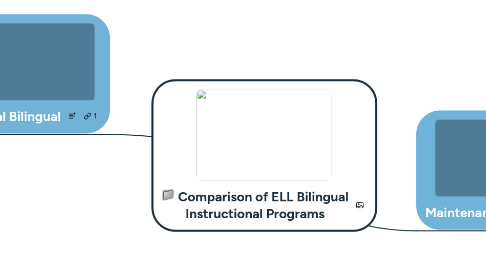
1. Transitional Bilingual
1.1. Problems and Criticism
1.1.1. The time limit for English language acquisition is not enough for many students and does not translate into skills appropriate enough to utilize in an academic environment.
1.1.2. Students may still be stigmatized as limited English proficiency (LEP) speakers or of low intelligence according to standardized test results in their second language.
1.1.3. Students integrate better on a social level when they do not have remedial education away from other students
1.2. Goals and Standards
1.2.1. Help students adjust to society as soon as possible so they can make a living in the future
1.2.2. Teach English to students in their native language so they can integrate into English-speaking society
1.2.3. Softens the shock of changing the language use of children by teaching in sheltered or simplified English
1.2.4. One aim is monolingualism. Instruction is temporary because the aim is to leave the native language behind. The dominant culture and identity are affirmed.
1.3. Teaching Strategies
1.3.1. Early Exit
1.3.1.1. Students are taught in their native language until they reach the level of 'Speech Emergence,' at which point they are transitioned into classes with English-only speakers.
1.3.2. Methods Include:
1.3.2.1. Extra-linguistic cues such as visual, props, and body language.
1.3.2.2. Linguistic modifications such as repetition and pauses during speech.
1.3.2.3. Interactive lectures with frequent comprehension checks.
1.3.2.4. Cooperative learning strategies.
1.3.2.5. Focus on central concepts rather than on details by using a thematic approach.
1.3.2.6. Development of reading strategies such as mapping and writing to develop thinking.
2. Maintenance Bilingual
2.1. Goals and Standards
2.1.1. Both languages are equally valued, and students can learn from each other.
2.1.2. Produces more global students
2.1.3. Promotes bilingualism and biculturalism
2.1.4. The aim is bilingualism and biliteracy. The student’s home culture and identity are affirmed
2.2. Problems and Criticisms
2.2.1. Dual immersion programs can discourage children from learning English since they already are attaining fluency in their native language.
2.2.2. Since the students are starting with limited or no skills in either language, it is argued that English should be given priority over the native language.
2.3. Teaching Strategies
2.3.1. Late Exit
2.3.1.1. Students attain fluency in both languages, and are then ready and more willing to participate in English-only academics.
2.3.2. From a cognitive perspective, students analyze the role of culture by listing the similarities and differences in American and their own language's use of words
2.3.3. The program should have a student-centered approach. Reciprocal interaction is preferable to teacher-centered knowledge transmission and is associated with higher-level cognitive skills
